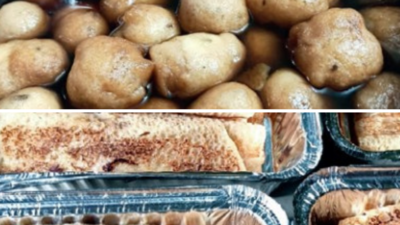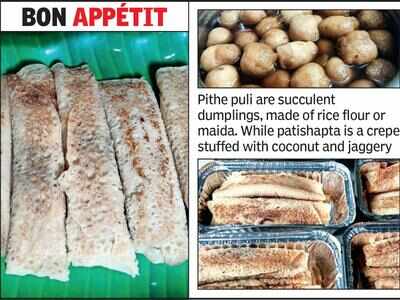Top Searches
- News
- City News
- nagpur News
- Of Poush Parbon and Bengalis’ love for pithe puli, patishapta
Of Poush Parbon and Bengalis’ love for pithe puli, patishapta
NAGPUR: As the city gets into festive mood with Makar Sankranti and gorges til gud, aromas of a different kind of traditional delicacies are wafting through the kitchens of Bengali households. For Bengali folks, the festivities of ‘Poush Parbon’ aren’t complete without having umpteen servings of pithe puli and patishapta.
Pithe puli are succulent, melt-in-your-mouth dumplings, made of rice flour or maida. The dumplings, with filling of grated coconut, are rolled in palm or nolen date jaggery and then boiled in thickened milk. While patishapta is a crepe stuffed with coconut and jaggery. Another sought after dish during ‘Poush Parbon’ is soru chakli, a thin dosa-like crepe, served with mouth-watering dipping of kheer or jaggery. Gurer payesh, made with freshly harvested rice and palm or date jaggery boiled in thickened milk, is another Bengali delicacy in demand during the festive season.
While these recipes are still prepared and enjoyed, it’s difficult to get many other exotic Bengali delicacies associated with ‘Poush Parbon’ in Nagpur nowadays. Many in the Bengali community fondly recall a mouthwatering variety of ‘gokul pithe’, which, as per legends, was a favourite of Lord Krishna. Similarly, chikui pithe and bibikhana pithe (Bangladeshi cake) too have entered the pages of history, they rue.
Divyendu Luha, investment consultant, sums up Bengalis’ love for festivities with a saying from the sweet language, ‘baro mase tero parbon’, meaning, 13 festivals in 12 months. The saying underlines Bengal’s rich socio-religious and cultural heritage. “I still remember my baba’s tarpan (hymns) for the ancestors, and the aroma wafting through the kitchen, where my mom and grandmother would be busy preparing the pithe puli, bora (fries of various vegetables) and other goodies which were first offered to Lokkhi Thakur (Goddess Laxmi) and then savoured by all, sitting under the Sun,” Luha recalled.
Revealing his sweet tooth, former commissioner of police PKB Chakraborty, who had retired as director general of police, said he loved pithe puli and dudh (milk) puli, but patishapta was his all-time favourite.
Former director of MOIL, Dipankar Shome, said the mention of ‘Poush Parbon’ itself takes him down the memory lane. “In our native place Medinapur, an annual fair would be organized, for which we waited yearlong. Freshly harvested rice would be brought home,” said Shome.
For renowned medical practitioner Dr Shantanu Sengupta, and human right activist Arup Mukherjee, pithe puli is much more than a delicacy. It is a bond connecting them with childhood memories. “We bring jaggery in bulk from Kolkata for these delicacies to be prepared at home,” said Dr Sengupta, who is keen to introduce the exotic taste of these Bengali desserts to his two sons. “Moreover, jaggery is far better for health and immunity than sugar,” he said.
These delicacies have been mentioned in Bengali literature too, Mukherjee said. “Many authors have described how characters of their stories were connected to these delicacies. Interestingly, some of them also highlighted the subtle differences in recipes of two Bengals, West and East, along with their tastes,” Mukherjee said.
Housewife-turned-aspiring food business owner Runa Choudhury said she is flooded with orders for dudh puli, patishapta, rosbhora and kheer patishapta during the season. “I had to drop soru chakli from the menu due to time constraints. I’m already working round the clock,” said Choudhury.
Dr Anindya Mukherjee, head of the department of forensic, GMCH, is elated that his wife Nilanjana and her mother Jharna have already started the preparation to make pithe puli at home.
Pithe puli are succulent, melt-in-your-mouth dumplings, made of rice flour or maida. The dumplings, with filling of grated coconut, are rolled in palm or nolen date jaggery and then boiled in thickened milk. While patishapta is a crepe stuffed with coconut and jaggery. Another sought after dish during ‘Poush Parbon’ is soru chakli, a thin dosa-like crepe, served with mouth-watering dipping of kheer or jaggery. Gurer payesh, made with freshly harvested rice and palm or date jaggery boiled in thickened milk, is another Bengali delicacy in demand during the festive season.
While these recipes are still prepared and enjoyed, it’s difficult to get many other exotic Bengali delicacies associated with ‘Poush Parbon’ in Nagpur nowadays. Many in the Bengali community fondly recall a mouthwatering variety of ‘gokul pithe’, which, as per legends, was a favourite of Lord Krishna. Similarly, chikui pithe and bibikhana pithe (Bangladeshi cake) too have entered the pages of history, they rue.
Divyendu Luha, investment consultant, sums up Bengalis’ love for festivities with a saying from the sweet language, ‘baro mase tero parbon’, meaning, 13 festivals in 12 months. The saying underlines Bengal’s rich socio-religious and cultural heritage. “I still remember my baba’s tarpan (hymns) for the ancestors, and the aroma wafting through the kitchen, where my mom and grandmother would be busy preparing the pithe puli, bora (fries of various vegetables) and other goodies which were first offered to Lokkhi Thakur (Goddess Laxmi) and then savoured by all, sitting under the Sun,” Luha recalled.
Revealing his sweet tooth, former commissioner of police PKB Chakraborty, who had retired as director general of police, said he loved pithe puli and dudh (milk) puli, but patishapta was his all-time favourite.
Former director of MOIL, Dipankar Shome, said the mention of ‘Poush Parbon’ itself takes him down the memory lane. “In our native place Medinapur, an annual fair would be organized, for which we waited yearlong. Freshly harvested rice would be brought home,” said Shome.
For renowned medical practitioner Dr Shantanu Sengupta, and human right activist Arup Mukherjee, pithe puli is much more than a delicacy. It is a bond connecting them with childhood memories. “We bring jaggery in bulk from Kolkata for these delicacies to be prepared at home,” said Dr Sengupta, who is keen to introduce the exotic taste of these Bengali desserts to his two sons. “Moreover, jaggery is far better for health and immunity than sugar,” he said.
These delicacies have been mentioned in Bengali literature too, Mukherjee said. “Many authors have described how characters of their stories were connected to these delicacies. Interestingly, some of them also highlighted the subtle differences in recipes of two Bengals, West and East, along with their tastes,” Mukherjee said.
Housewife-turned-aspiring food business owner Runa Choudhury said she is flooded with orders for dudh puli, patishapta, rosbhora and kheer patishapta during the season. “I had to drop soru chakli from the menu due to time constraints. I’m already working round the clock,” said Choudhury.
Dr Anindya Mukherjee, head of the department of forensic, GMCH, is elated that his wife Nilanjana and her mother Jharna have already started the preparation to make pithe puli at home.
Start a Conversation
FOLLOW US ON SOCIAL MEDIA
FacebookTwitterInstagramKOO APPYOUTUBE












